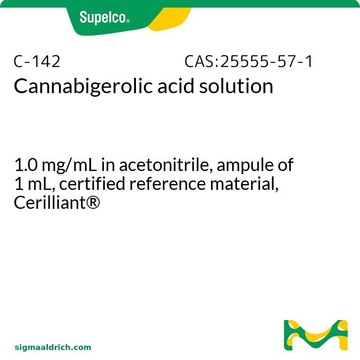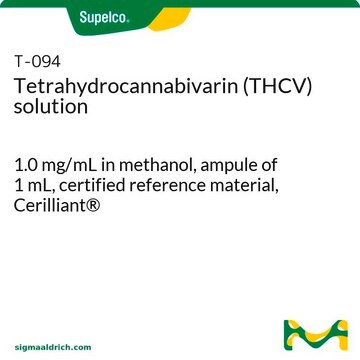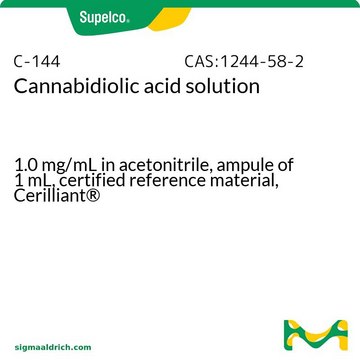C-140
Cannabidivarin solution
1.0 mg/mL in methanol, ampule of 1 mL, certified reference material, Cerilliant®
Synonyme(s) :
CBDV solution
About This Item
Produits recommandés
Qualité
certified reference material
Niveau de qualité
Forme
liquid
Caractéristiques
(Snap-N-Spike®)
Conditionnement
ampule of 1 mL
Fabricant/nom de marque
Cerilliant®
Concentration
1.0 mg/mL in methanol
Technique(s)
gas chromatography (GC): suitable
liquid chromatography (LC): suitable
Application(s)
cannabis testing
cannabis testing
Format
single component solution
Température de stockage
−70°C
InChI
1S/C19H26O2/c1-5-6-14-10-17(20)19(18(21)11-14)16-9-13(4)7-8-15(16)12(2)3/h9-11,15-16,20-21H,2,5-8H2,1,3-4H3
Clé InChI
REOZWEGFPHTFEI-UHFFFAOYSA-N
Description générale
Cannabidivarin (CBDV) is a non-psychoactive phytocannabinoid that belongs to the class of C21 terpenophenolic compounds. It is found in Cannabis that reportedly has therapeutic efficacy in the treatment of pain, mood disorders, and inflammatory diseases.
Application
- Determination of eight cannabinoids in eight hemp samples and 12 forensic cannabis samples using reversed phase-high-pressure liquid chromatography (RP-HPLC) in combination with UV detector
- Analysis of 13 oil samples obtained from hemp for seven major cannabinoids using high-performance liquid chromatography (HPLC) combined with UV detection
- Development of a rapid liquid chromatographic (LC) method for the separation and identification of cannabidiol, cannabidivarin, Δ9-tetrahydrocannabivarin, and cannabigerol in mouse tissue samples in combination with tandem mass spectrometry (MS/MS)
- Detection and quantification of cannabidiol, tetrahydrocannabinol, cannabinol, tetrahydrocannabivarin, cannabidivarin, and cannabigerol by liquid chromatography coupled with mass spectrometry in positive electrospray ionization (ESI) mode from hemp plants
- Development and validation of an LC method combined with a UV detector for impurity analysis of cannabidivarin and cannabidibutol in cannabidiol obtained from hemp extracts
Caractéristiques et avantages
- Fully characterized under ISO/IEC 17025 and ISO 17034 accreditation
- Accompanied with a comprehensive Certificate of Analysis (CoA) with data on stability, homogeneity, accuracy of concentration, uncertainty, and traceability
- Rigorously tested through real-time stability studies to ensure accuracy and shelf life
- Gravimetrically prepared using qualified precision balances to ensure minimal uncertainty
- Flame sealed under argon into ampoules for long-term shelf life
- Offered in a convenient, DEA-exempt format to improve laboratory efficiency
Informations légales
Produit(s) apparenté(s)
Mention d'avertissement
Danger
Mentions de danger
Conseils de prudence
Classification des risques
Acute Tox. 3 Dermal - Acute Tox. 3 Inhalation - Acute Tox. 3 Oral - Flam. Liq. 2 - STOT SE 1
Organes cibles
Eyes,Central nervous system
Code de la classe de stockage
3 - Flammable liquids
Classe de danger pour l'eau (WGK)
WGK 2
Point d'éclair (°F)
49.5 °F - closed cup
Point d'éclair (°C)
9.7 °C - closed cup
Certificats d'analyse (COA)
Recherchez un Certificats d'analyse (COA) en saisissant le numéro de lot du produit. Les numéros de lot figurent sur l'étiquette du produit après les mots "Lot" ou "Batch".
Déjà en possession de ce produit ?
Retrouvez la documentation relative aux produits que vous avez récemment achetés dans la Bibliothèque de documents.
Les clients ont également consulté
Articles
As the popularity of cannabis-infused products increases, there is a growing need to characterize the type and content of the cannabinoids found in the product. This application demonstrates the ability of the Ascentis Express C18 column to baseline resolve 14 structurally-similar cannabinoids, in under seven minutes, with excellent peak shape.
A comprehensive high performance liquid chromatography-diode array detection (HPLC-DAD) workflow for the analysis of 14 cannabinoids in hemp bud extracts within 10 minutes using robust Chromolith® monolithic silica HPLC columns with low column back pressure.
The cannabinoids found in the Cannabis plant commonly referred to as marijuana, have grown in popularity for treating a variety of ailments from arthritis, glaucoma, and chronic pain to malnutrition, multiple sclerosis, and cancer.
Tetrahydrocannabinolic acid A solution, 1.0 mg/mL in acetonitrile, ampule of 1 mL, certified reference material.
Protocoles
Rapid potency testing of marijuana-infused edibles using LC/MS on a biphenyl stationary phase detected eleven cannabinoids.
Tetrahydrocannabinolic acid A solution, 1.0 mg/mL in acetonitrile, ampule of 1 mL, certified reference material; Cannabichromenic Acid (CBCA) solution, 1.0 mg/mL in acetonitrile, certified reference material, ampule of 1 mL
As the popularity of cannabis-infused products increases, there is a growing need to characterize the type and content of the cannabinoids found in the product. This application demonstrates the ability of the Ascentis Express C18 column to baseline resolve 14 structurally-similar cannabinoids, in under seven minutes, with excellent peak shape.
HPLC separation of 17 important cannabinoids including CBD, delta 9 THC and THCA. Read the application note
Notre équipe de scientifiques dispose d'une expérience dans tous les secteurs de la recherche, notamment en sciences de la vie, science des matériaux, synthèse chimique, chromatographie, analyse et dans de nombreux autres domaines..
Contacter notre Service technique














